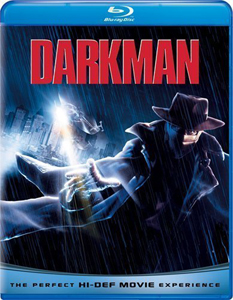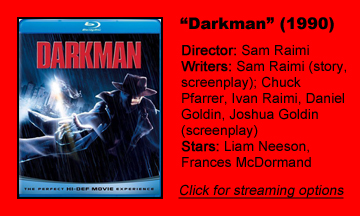It’s hard to believe now, but in 1990, director Sam Raimi (the “Evil Dead” trilogy) couldn’t get any superhero property to let him make it into a movie, so he did something that’s largely foreign by today’s standards: He invented his own character.
The titular hero of “Darkman” (1990) is inspired by the Invisible Man in look and attitude, but there’s a lot of originality and a do-it-yourself attitude to admire about this entry from the superhero genre’s pre-boom era.
Made on the cheap
“Darkman” is not as good as Raimi’s later “Spider-Man” films, largely because of the thinness of the screenplay by Raimi and four other writers. The special effects are relatively cheap (we can see the outlines on green screen shots) but not in a bothersome way; Raimi clearly has fun making movies, and gets maximum bang for his buck on every shot.
For example, Darkman is dangling from a helicopter over highway traffic and he briefly scampers across the top of the semi rushing beneath him. It doesn’t look all that believable, but it’s not something you see in every movie.
“Darkman” isn’t deadly serious, but nor is it campy; it’s in that middle ground that’s perfect for “Spider-Man” but arguably not ideal here, in what should be a moodier film.
Peyton/Darkman (Liam Neeson) is burned when the bad guys blow up his science lab in an unnamed city (which the web tells me is Detroit, with Los Angeles standing in). Fortunately, he happens to be working on synthetic skin, but the skin only holds up for 100 minutes in the daylight.
The villains actually don’t have anything against Darkman at first; he just happens to be the boyfriend of lawyer Julie (Frances McDormand), who accidentally possesses a crooked corporation’s damning document, which he accidentally takes to the lab.
Before they were stars
It’s weird to see Neeson and especially McDormand in a low-budget superhero film. Since they would now be considered A-list casting, it seems like “Darkman” doesn’t take full advantage of their skills.
They have good chemistry; I know Peyton and Julie love each other — indeed, they seem to be married already, and are debating whether to take that official step. But the core issues of whether Julie can love Peyton if he’s hideously scarred, and whether he wants her to, are given cursory treatment.
Neeson is fine, but he doesn’t register as the actor behind Darkman. His face is often bandaged, and Neeson seems to shy away from his natural Irish accent. At other times Darkman uses his “Mission: Impossible”-esque false faces to take on the role of various villains to infiltrate their organization.
Larry Drake is particularly effective as both mob boss Durant and Darkman-as-Durant. Colin Friels is appropriately smarmy as corrupt urban developer Louis Strack Jr. (That must be a play on Marvel’s Stark family, right?) He’s a rare actor who makes me think of the usually incomparable Christopher Walken in the way he chews his words.
Elfman’s score stands out
Danny Elfman’s score is almost good enough to buy it on CD, with one snippet that sounds very much like the Battle of Hoth (the downside: it’s not good to have viewers thinking of better movies). And the final showdown on skyscraping construction beams at night is striking, although sometimes the green-screen matting is noticeable.
“Teenage Mutant Ninja Turtles” was the bigger superhero movie of 1990, as well it should be; it’s superior. But “Darkman” (which spawned two direct-to-video sequels) has a similar charm wherein the filmmakers’ hearts are in it, even if they aren’t armed with the best screenplay or the most money.
If nothing else, it has a key place in genre history as a calling card for Raimi, who would be the man to finally bring Spider-Man to the big screen 12 years later.



